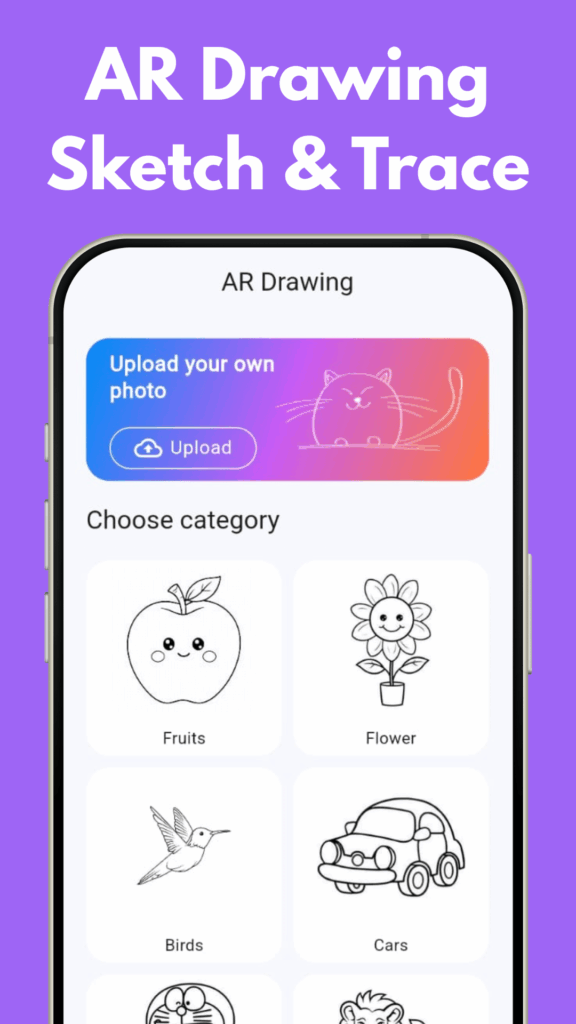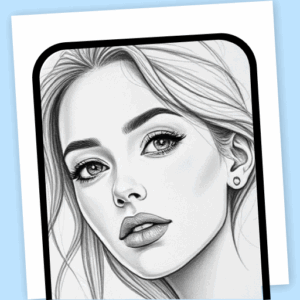An AR drawing app lets users create artwork that appears in the real world through their device’s camera. It combines digital drawing tools with augmented reality to make creative designs float in physical spaces. This technology brings a new way to express creativity beyond traditional screens.
Many people use AR drawing apps for hobbies, education, and even professional design work. These apps offer easy-to-use tools that blend the real and virtual worlds, making drawing more interactive and engaging. They are changing how people think about art and technology together.
As AR technology improves, these drawing apps are becoming more popular and powerful. Users can expect more features, better accuracy, and creative possibilities that were not possible before.

Key Takeaways
- AR drawing apps mix digital art with the real world through a device’s camera.
- They offer tools that encourage creativity and new ways to engage with drawing.
- The technology is evolving, making these apps more useful and fun over time.
What Is an AR Drawing App
An AR drawing app lets users create artwork in a real-world space using augmented reality technology. These apps blend digital drawings with physical surroundings through a device’s camera and screen.
Core Features of AR Drawing Apps
AR drawing apps typically include tools like virtual brushes, colors, and shapes. Users draw by moving their device or finger in 3D space. The app maps the real environment so drawings stay fixed in place.
Most apps allow users to save and share their 3D artwork. Some support layers, which help organize different parts of a drawing. Others offer gesture controls to switch tools or undo actions quickly.
The ability to see drawings from multiple angles is key. Some apps also include animation features, letting users create moving drawings in augmented space.
How AR Drawing Differs From Traditional Drawing
AR drawing does not happen on paper or a flat screen. Instead, it occurs in 3D space, meaning lines and shapes appear around the user’s environment. This adds a depth element missing from traditional drawing.
Users must move around to view the drawing from different sides. Traditional drawing is limited to one flat view. Also, AR drawing tools work with gestures and device movements rather than just a pen or brush.
This technology allows for more interactive and immersive art experiences. It also opens new ways to combine physical and digital elements in creative work.
Benefits of Using AR Drawing Apps
AR drawing apps offer practical ways to improve creativity and learning. They make it easier for users to practice drawing skills and explore new ideas. These apps provide hands-on experiences that engage both beginners and experts.
Enhanced Learning and Skill Development
AR drawing apps help users learn by combining real-world objects with digital drawings. This layered approach allows users to see how their sketches fit into real spaces. It improves spatial awareness and hand-eye coordination.
Users can practice repeatedly without wasting materials like paper or ink. Many apps have tools to guide drawing techniques, such as grids and tracing features. These tools support steady skill growth and confidence in drawing abilities.
Accessibility for Beginners and Experts
AR drawing apps are designed to be user-friendly for people at any skill level. Beginners can start with simple shapes and use step-by-step tutorials built into the apps. Experts can take advantage of advanced tools like 3D modeling and precise color options.
The apps often work on common devices like smartphones and tablets. This means users don’t need expensive equipment to start drawing in AR. The easy access encourages more people to try digital art without feeling overwhelmed.
Interactive and Immersive Experience
These apps create an interactive space by blending physical surroundings with digital content. Users can walk around their drawings and view them from different angles. This immersion helps them understand proportions and perspectives better.
Many AR drawing apps allow sharing artwork in real time. This social feature adds motivation and connects users with others remotely. The active experience keeps users more engaged than traditional drawing on paper.
Key Features to Look For
The app should offer a variety of drawing tools designed for precision and creativity. It must handle layers well and support 3D object use to blend AR with easy editing. Exporting and sharing options are crucial for saving work and showing it on different platforms.
Drawing Tools and Brushes
Strong drawing apps provide multiple brush types such as pencil, pen, marker, and spray. These tools often come with adjustable settings like size, opacity, and flow. Pressure sensitivity is important for users with styluses, allowing for more natural strokes.
The app should also include erasers and shape tools to correct mistakes quickly. Color palettes with customization options help users pick exact shades. Some apps offer blending modes to mix colors realistically in AR space.
Layering and 3D Object Integration
Layers allow artists to work on different parts of a drawing without affecting others. The app should let users add, hide, and reorder layers easily. Transparency controls for layers help with detailed adjustments.
Integration with 3D objects means users can place and draw on AR shapes. The app should support importing and modifying these objects. Good apps let users rotate and scale 3D models while drawing on their surfaces.
Export and Sharing Options
Users need multiple export formats such as PNG, JPG, and sometimes GIF or video. High-resolution exports are necessary for printing or professional use. The app should support cloud saving to prevent data loss.
Sharing tools that connect directly to social media or messaging apps improve the experience. Some apps include native collaboration features so multiple people can work on the same AR project remotely.
Popular AR Drawing Apps
Several AR drawing apps stand out due to their features, user experience, and platform compatibility. These apps cater to different needs, from casual doodling to detailed 3D sketches.
Overview of Leading AR Drawing Apps
Tilt Brush by Google offers a simple interface for creating 3D art in virtual space. It is popular among beginners and professionals for its intuitive tools and brush variety. It works well with VR headsets like Oculus and HTC Vive.
SketchAR combines drawing with augmented reality on smartphones. It helps users trace images projected onto real-world surfaces. Its ability to guide users makes it suitable for learning and practicing drawing.
Just a Line, created by Google, is a basic AR drawing app designed for quick, fun sketches on smartphones. It emphasizes simplicity and social sharing.
Unique Capabilities of Top Apps
Tilt Brush supports complex, multi-colored strokes and animation, allowing artists to build layered compositions. It also supports exporting work for 3D printing or further editing.
SketchAR uses AI to adapt drawings to different surfaces and scales automatically. It offers lessons and templates, making it both a tool and an educational app.
Just a Line focuses on accessibility. Its minimal tools encourage creativity without technical barriers and supports recording AR drawings as short videos for sharing.
| App Name | Platform | Key Feature | User Level |
|---|---|---|---|
| Tilt Brush | VR Headsets | 3D multi-colored strokes | Beginner to Expert |
| SketchAR | iOS, Android | AI tracing & lessons | Beginner to Intermediate |
| Just a Line | iOS, Android | Simple AR sketches | Casual users |
How to Choose the Right AR Drawing App
Choosing an AR drawing app depends on the device being used and how easy the app is to navigate. These factors affect how well the app works and how much the user enjoys creating art.
Compatibility and Platform Support
The app must work well on the user’s device. Some apps only run on specific platforms like iOS or Android. Others support multiple platforms, including tablets, smartphones, and sometimes even AR glasses.
Users should check the device’s operating system version before downloading. For example, an app may require iOS 14 or later. Storage space and hardware features like cameras or sensors also matter. Some AR apps need powerful processors or special sensors to function properly. Ensuring the app matches the device avoids crashes and poor performance.
User Interface and Usability
A clear and simple interface helps users focus on drawing rather than learning complicated controls. The app should offer easy access to tools like brushes, colors, and layers. Icons and menus must be intuitive and not clutter the screen.
Usability includes how quickly users can start projects and save or share their work. Helpful features include undo/redo buttons, tutorials, and customizable settings. If an app is complicated, users may get frustrated and stop using it. Good usability supports creativity by making the drawing process smooth and enjoyable.
Creative Uses and Applications
AR drawing apps open up new ways to create and share visual ideas. Many users apply them to learning, professional projects, and fun personal creations. The tools allow for interactive and immersive experiences not possible with traditional drawing.
Educational Settings and Art Classes
In schools and art classes, AR drawing apps help students learn by making lessons more interactive. Students can draw in 3D, which aids in understanding shapes, space, and design principles better than flat paper.
Teachers use these apps to explain complex concepts clearly by showing virtual models in real space. This approach also encourages creativity and engagement among young learners.
Apps often include guided tutorials and instant feedback, which help students improve their skills quickly. They can share their work easily, which supports group projects and peer review.
Professional Art and Design
Artists and designers use AR drawing apps to visualize ideas before making physical models or digital 2D images. The ability to sketch in 3D helps them see proportions and angles more accurately.
These apps support workflows in architecture, fashion design, and product development. Designers can create quick drafts and test ideas in a real-world context without building prototypes first.
Clients can view and interact with these virtual drawings, improving communication in projects. This reduces misunderstandings and speeds up approval processes.
Entertainment and Personal Projects
Hobbyists and casual users find AR drawing apps fun for creating art anywhere, anytime. The apps allow users to express ideas by drawing on walls, floors, or objects around them.
People use these apps to make personalized gifts, decorations, or simple animations. The tools often include sharing features, making it easy to show creations on social media or with friends.
Some apps also offer challenges or community galleries, motivating users to improve skills and enjoy drawing regularly.
Future Trends in AR Drawing Technology
AR drawing technology is evolving with new features that improve ease of use and the hardware that supports it. These changes will make AR drawing more responsive and realistic for users.
AI Integration and Smart Features
AI is becoming a key part of AR drawing apps. It helps by suggesting shapes, colors, and effects based on what the user draws. This can speed up the creative process and improve accuracy.
Some apps use AI to correct mistakes automatically or fill in missing parts. Others offer smart brushes that change texture or style depending on the drawing context.
AI also enables voice commands and gesture recognition, letting users control the app hands-free. These smart features make AR drawing more accessible and efficient.
Advancements in Hardware Capabilities
Hardware improvements are making AR drawing smoother and more detailed. New AR glasses and headsets have better screens with higher resolution and wider fields of view.
These devices also offer faster processors and improved sensors. This allows for quicker response times and more precise tracking of hand movements.
Battery life is getting longer, so artists can work for extended periods without recharging. Lightweight designs make hardware easier to wear, increasing comfort during use.
